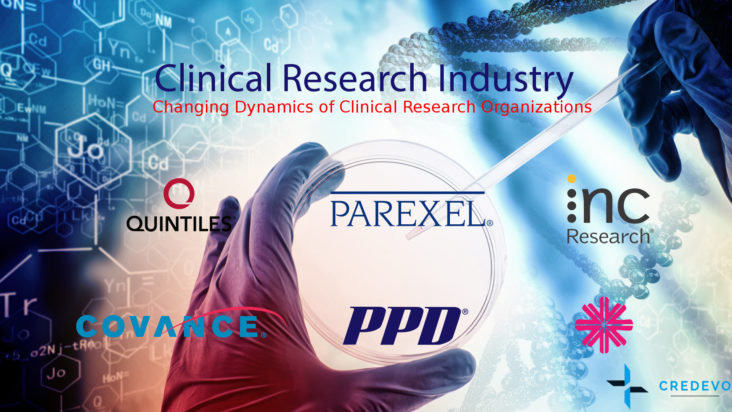Clinical Research Industry: Changing Dynamics Of Clinical Research Organizations – Part 1

The clinical research industry has grown to be an integral part of the bigger pharmaceutical industry today. It helps pharma companies conduct research faster and in much more productive ways. In today’s drug development cost of 2.6 billion per new molecule, clinical trials hold about 70% share, which means that any changes in this industry affect the pharma industry as a whole.

This also effectively turns it into an economic powerhouse. As we discussed in our previous blog post, clinical research organizations (CRO) market around the world has been growing steadily over past several years and the revenue figures of industry signal huge potential going forward.

Today, this industry is led by major players including Quintiles, INC, PAREXEL, Covance, ICON, and PRA Health Sciences. However, there are developments happening around in this industry that could change the way we see it today. While on one hand, there are synergies being explored creating huge entities, on the other hand, there is almost a war going on the talent in the industry driving employee turnovers. This is resulting in some players retreating, others leaping forth.
First – and perhaps foremost – of these is the merger between Quintiles and IMS Health.
Quintiles and IMS Health
The merger of Connecticut-based IMS Health and North Carolina-based Quintiles was announced in May 2016 and was completed five months later in October 2016. The resulting firm, Quintiles IMS Holdings is the world’s largest pharmaceutical services provider, with over 50,000 employees and a market value of $18 billion.
Individually, both companies have a presence in about 100 countries.
Standing alone, IMS was assisting pharmaceutical, consumer health, medical device manufacturers, and others with their analytics and healthcare information data, while Quintiles was focusing on end to end delivery services in clinical research segment.
IMS was considered the largest vendor of U.S. physician prescribing data. It was best known for its collection of healthcare information spanning sales, de-identified prescription data, medical claims, electronic medical records, and social media. Quintiles on the other hand were the largest provider of clinical research services and already a leader on in the clinical trial services market.
Coupling of these two mega-companies resulted in a behemoth that has a series of services and capabilities for the pharma industry to utilize them. This merger has resulted in an entity that:
- Works to provide one of the most reputed sets of clinical trial services
- Uses vast anonymous patient records to improve research parameters and commit resources accordingly.
- offers market insights, developmental expertise, and great connectivity across the pharma-physician-patient chain.
Financially, the creation of Quintiles IMS Holdings promises unprecedented growth and savings:
- A projected increase of between 100 and 200 basis points to their combined growth rate by the end of the third year
- An anticipated $100 million cost savings on annual run-rate by the end of the third year
- A combined gross and net leverage as of December 31, 2015, of 4.0 times and 3.2 times adjusted EBITDA for financial flexibility.
With such promising foresight, QuintilesIMS stands to gain a lot from the clinical research industry. At the time of its creation, it offered much more than its competitors could.
Talking about competitors, there is another development that happened about a year after QuintilesIMS news. Not a positive one and in fact, it provides a negative outset to what might happen in the industry going forward.
Covance
- Princeton, New Jersey-based CRO, Covance Inc. announced in late April that it would be laying off over 100 employees at its Evansville, Indiana laboratory.
- The terminations will begin in late July and are expected to be permanent. Covance has made clear that the affected employees have no collective bargaining agreement clause in their contracts. The lab in question conducts medical research studies on healthy people and those with chronic conditions, including cholesterol, diabetes, and obesity.
- It is believed that the layoffs are a result of two major clinical trial cancellations in 2016. The company’s revenue slid to $690.3 million in the first quarter of 2017, a drop of 2%. Its operating income in the same period dropped to $83.5 million, a decrease of almost 20% compared to the same period last year.
- Covance is a subsidiary of the Laboratory Corporation of America (LabCorp), which acquired Covance in 2015 for $6.1 billion. The parent company indicates that there might be more facility closures and layoffs to come. Covance has worked on all of the top 50 best-selling drugs available today through its full spectrum of nonclinical, clinical and commercialization services.
- With annual revenue of over $2 billion and 15,000 staff in over 60 countries worldwide, Covance has the planet’s largest central laboratory network. It also has laboratories in Indianapolis and Greenfield.
Going Forward
This has started an interesting era, where we are seeing mega-merger happening alongside shut down of facilities. From a commercial point of view, both may be making a lot of sense. However, from an industry growth perspective, it’s giving clear foresight as to what more may happen in the future.
However, the game has just started. While QuintilesIMS might have become the biggest entity in the clinical research and biopharma services sector, others are not going to lie down. We’re expecting more similar news coming to the market very soon.
Check out the next set of “Latest developments that are changing the face of clinical research industry – part 2“, where we share developments about 2-3 more companies that will change the industry.
2 thoughts on “Clinical Research Industry: Changing Dynamics Of Clinical Research Organizations – Part 1”
Comments are closed.